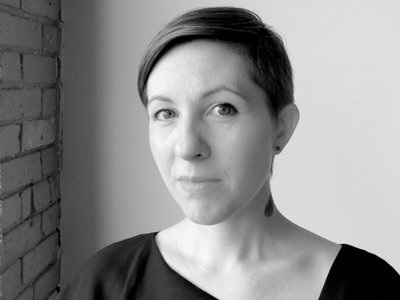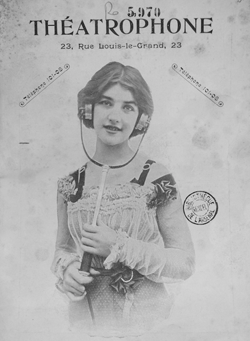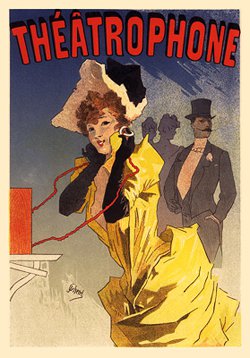Full Stream Ahead
Music historian Sarah Fuchs Sampson traces technology and access to opera

Throughout most of the 19th century, people went to the opera house and theater to enjoy entertainment in real time. Although low-price tickets were available, it was the well-heeled elite who could afford to regularly attend such performances. When gramophones became popular in the 1890s and early 1910s, music lovers from a wider range of socioeconomic backgrounds could listen to recordings in their homes. Around the same time, inventors in Paris devised a way to transmit real-time opera performances through telephone wires to hotel lobbies, cafés and bars, as well as to people’s homes.
This transmission technology, known as the théâtrophone, was “widespread in France well into the 1930s, only declining in popularity alongside the rise of handheld radio technologies,” says Sarah Fuchs Sampson, assistant professor of music history and cultures in the College of Arts and Sciences. “The théâtrophone was the predecessor of livestreaming.”
Technological developments including the théâtrophone and the gramophone made opera accessible to a broader audience, Fuchs Sampson explains. This new audience engaged with opera in complex and multifaceted ways, often using technology to exercise their individual tastes rather than relying solely on the opera house’s programming, she adds.
“I’m interested in how people used these technologies to intervene in French operatic culture,” she says. Her research on the intersections between 19th- and early 20th-century music history and the history of technology informs a new Central New York Humanities Corridor Working Group: Sound and Media. “We’ve designed the group to draw scholars with diverse approaches to sound and media technologies together,” she says.

The group is among dozens of faculty projects since the Humanities Corridor was founded in 2005. Syracuse University, Cornell University and the University of Rochester are partners in the collaborative interdisciplinary project, which studies timely issues in the humanities. Also involved is the New York Six Liberal Arts Consortium (Colgate and St. Lawrence universities, as well as Hamilton, Skidmore, Union and Hobart and William Smith colleges).
In 2014, the Andrew W. Mellon Foundation awarded the Humanities Corridor grants totaling $3.55 million, including a $2 million endowment for Syracuse.
Fuchs Sampson and Darren Mueller, assistant professor of musicology at the University of Rochester’s Eastman School of Music, organized the first of two Corridor seminars in April. “Sounding Identities: Media and the Sonic Signification of Difference,” held at the University of Rochester, was led by Meina Yates-Richard, assistant professor of English in Syracuse’s College of Arts and Sciences.
“In the workshop, Meina encouraged us to consider how the prologue of Ralph Ellison’s ‘The Invisible Man’—in which the protagonist narrates his experience of listening to a recording by Louis Armstrong—evoked sounds closely tied to African American culture,” Fuchs Sampson says. The group listened to Louis Armstrong’s and Edith Wilson’s recordings of “Black and Blue” and discussed how each performer engaged with sonic constructions of race and gender.
Participants included scholars in music history, musicology, African American studies and English. “We had to listen to one another more carefully because we’re not from the same disciplines,” Fuchs Sampson says. “The working group environment provides a wonderful opportunity not only to collectively analyze the cultural resonances of sound recordings, but also to exercise our abilities to listen to one another.”

The group will host a mini-seminar titled “Sound Reproduction and the Media of Preservation” at Syracuse University in the fall. That seminar will focus on the aesthetics, theories and social practices surrounding sound reproduction from the late 19th century through the present day.
Fuchs Sampson’s work with the Humanities Corridor comes as she’s learning her way around Syracuse after completing her Ph.D. at the Eastman School of Music at the University of Rochester in 2016. She points to the Belfer Audio Archive as a treasure. The Archive’s collection includes 10- and 12-inch 78 rpm recordings, cylinders and specialized discographies, books and periodicals. “The Belfer is one of the largest sound archives in the United States, and its collection of cylinder records—which were manufactured between about 1896 and 1915—is one of the largest in the world,” Fuchs Sampson says. “The Belfer Audio Archive was one of the major things that drew me to Syracuse University.”
Her scholarly focus evolved from a love of musical performance (in addition to her training as a musicologist, she is a professional pianist) and an interest in French history and culture. A three-month fellowship took her to Paris to work in archives including the Bibliothèque nationale, the Archives nationales and Cinémathèque française, where she researched the ways emerging technologies such as the telephone, gramophone, camera and early synchronized sound film changed the way opera was made and consumed at the end of the 19th and the beginning of the 20th century. “As I spent time in the archives, I found that Paris was a hotbed for audiovisual technological invention during these decades,” she explains.
After the French nation’s defeat in the Franco-Prussian War of 1870, France established the Third Republic. “Under the Third Republic, the government used art and music to educate the public,” Fuchs Sampson says. “France was trying to rebuild and construct a sense of national history.” But rather than the edification the government sought, many people used technology to destabilize and disrupt the Third Republic’s efforts to construct a new nation through opera.
She’ll continue researching the topic in June and July, when she spends a few weeks in Paris before traveling to the Transnational Opera Studies Conference in Bern, Switzerland. At the conference, she will deliver a talk, “Performing Provence: Emma Calvé and the ‘Chanson de Magali’ at the Opéra-Comique, in Arles, and on the Phonograph.” She was invited to deliver a keynote address this summer after winning the prize for Best Paper by a Scholar under the Age of 35 at the 2015 Transnational Opera Studies Conference in Bologna, Italy.
Her talk is about a 1902 recording of a Provençal folk tune made by Calvé, a singer from the Aveyron region in the south of France, an area whose residents retained their Provençal dialects long after the French government sought to nationalize the Parisian dialect. “She was proud to be from Aveyron,” Fuchs Sampson says. “I argue that Calvé used a folk tune, a distinctive vocal technique and sound recording technologies to assert her Provençal heritage.”
Fuchs Sampson sees a growing democratization of opera as technology evolves. Before the théâtrophone’s invention, it was impossible to experience real-time musical performances at a distance. Now, the Metropolitan Opera regularly offers “Live in HD” screenings of its operatic productions at cinemas across the country, and 15 opera houses across Europe allow for free online streaming of their performances via the Opera Platform, a website backed by the European Union’s cultural budget. “Technology offers us a means of engaging with a wider array of operatic productions across the globe than ever before possible,” she says.
Featured
Sarah Fuchs Assistant Professor and Director of Undergraduate Studies in Music History and Cultures
